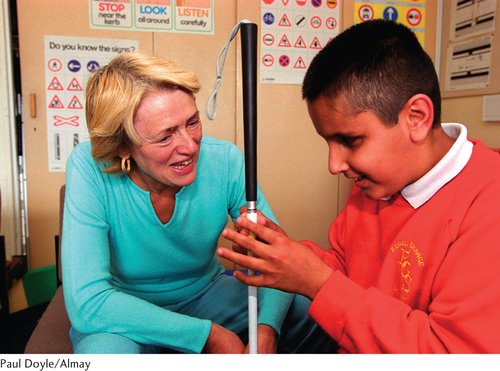14
Molecular Genetic Analysis and Biotechnology
Helping the Blind To See

Genetic engineering, the manipulation of genes and their transfer from one organism to another, has revolutionized the study of genetics and has been successfully used to create a plethora of new products, including bacteria that generate chemicals, pest-
Eyesight is the most precious of the human senses, enabling us to read, navigate physical obstacles, recognize friends, and enjoy the stunning visual beauty of the natural world. Tragically, millions of people are blind or unable to see well. Eyesight often deteriorates with age—
Gene therapy has been applied to a rare genetic form of blindness known as Leber congenital amaurosis (LCA), in which there is a mutation in one of a number of genes that are responsible for the development of light receptors in the retina. LCA is inherited as an autosomal recessive disorder; in people with two defective copies of one of these genes, the light-
One type of LCA is caused by a defect in the RPE65 gene, which encodes an enzyme that helps convert vitamin A into rhodopsin, a pigment that absorbs light. Without the enzyme, rhodopsin is not produced, and the photoreceptor cells atrophy with the passage of time. In 1998, researchers discovered that some Swedish Briard dogs also have a defect in RPE65 and become blind. Research on these dogs led to a better understanding of how defects in RPE65 cause blindness and suggested a possible treatment: gene therapy. In 2001, researchers treated three young dogs with gene therapy. The dogs’ vision improved enough that they could avoid objects and navigate a maze.
In 2007, researchers in Pennsylvania and London used gene therapy to treat four young adults who had LCA. Each patient was injected with a genetically modified virus carrying a functional copy of RPE65. The results were dramatic: all the patients showed significant improvement in visual perception. Some who had formerly been able to detect only hand motions were now able to read several lines on an eye chart. One patient who had not been able to navigate an obstacle course was able to make his way through it. All four patients were still legally blind, but the results indicated that gene therapy can be an effective treatment for LCA. Researchers have now used gene therapy to treat a number of additional persons with LCA; the results have been particularly dramatic with younger patients, some of whose vision improved enough that they could play sports.
This chapter introduces some of the techniques used in molecular genetic analysis and genetic engineering. We begin by considering molecular genetic techniques and some of their effects. We then examine a number of methods used to isolate, study, alter, and recombine DNA sequences and place them back into cells. Finally, we explore some of the applications of molecular genetic analysis.